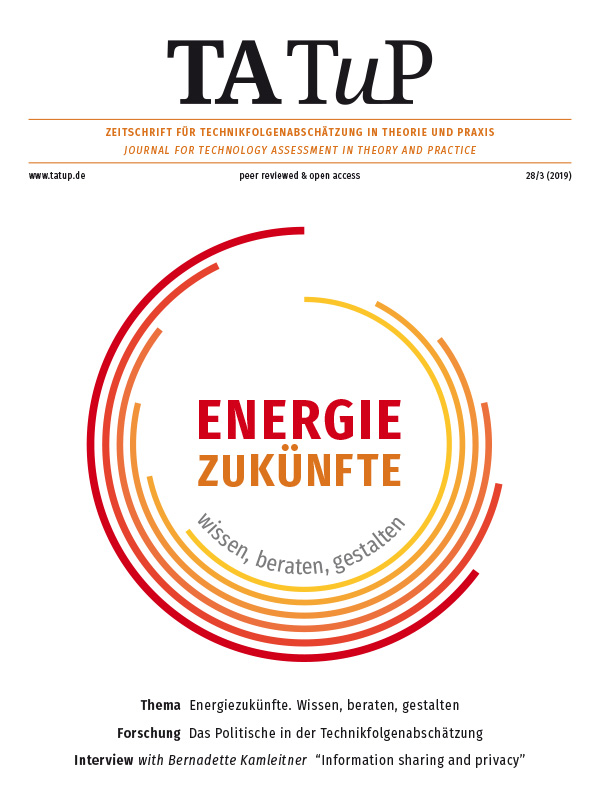How to deal with non-linear pathways towards energy futures
Concept and application of the cross-impact balance analysis
DOI:
https://doi.org/10.14512/tatup.28.3.20Keywords:
energy scenarios, dynamics, cross-impact balance analysisAbstract
Energy scenarios currently in use for policy advice are based on a number of simplifying assumptions. This includes, in particular, the linear extrapolation of trends. However, this approach ignores the fact that central variables were highly dynamic in the past. For an assessment of energy futures and the specification of measures, novel approaches are necessary which can implement non-linear trends. In this paper, we show how cross-impact balance (CIB) analysis can be applied to map dynamic trends. Using a small CIB model, we highlight the need for novel approaches in the creation and evaluation of energy futures and the possible contribution of CIB analysis.References
Alcamo, Joseph; Henrichs, Thomas (2008): Chapter two towards guidelines for environmental scenario analysis. In: Developments in Integrated Environmental Assessment 2, pp. 13–35. DOI: https://doi.org/10.1016/S1574-101X(08)00402-X
Ayres, Robert (2000): On forecasting discontinuities. In: Technological Forecasting and Social Change 65 (1), pp. 81–97. DOI: https://doi.org/10.1016/S0040-1625(99)00101-8
Azariadis, Costas; Drazen, Allan (1990): Threshold externalities in economic development. In: The Quarterly Journal of Economics 105 (2), pp. 501–526. DOI: https://doi.org/10.2307/2937797
Bauer, Nico et al. (2017): Shared socio-economic pathways of the energy sector. Quantifying the narratives. In: Global Environmental Change 42, pp. 316–330. DOI: https://doi.org/10.1016/j.gloenvcha.2016.07.006
Burt, George (2007): Why are we surprised at surprises? Integrating disruption theory and system analysis with the scenario methodology to help identify disruptions and discontinuities. In: Technological Forecasting and Social Change 74 (6), pp. 731–749. DOI: https://doi.org/10.1016/j.techfore.2006.08.010
Capros, Pantelis et al. (2016): EU Reference Scenario 2016. Publications Office of the European Union: Luxembourg.
de Bruyn, Sander; van den Bergh, Jeroen; Opschoor, Johannes (1998): Economic growth and emissions. Reconsidering the empirical basis of environmental Kuznets curves. In: Ecological Economics 25 (2), pp. 161–175. DOI: https://doi.org/10.1016/S0921-8009(97)00178-X
Döll, Petra; Krol, Maarten (2002): Integrated scenarios of regional development in two semi-arid states of North-Eastern Brazil. In: Integrated Assessment 3 (4), pp. 308–320. DOI: https://doi.org/10.1076/iaij.3.4.308.13588
EIA – Energy Information Administration (2019): Annual energy outlook 2019. Washington: U. S. Energy Information Administration.
Faber, Malte; Proops, John (1993): Evolution, time, production and the environment. Berlin: Springer-Verlag. DOI: https://doi.org/10.1007/978-3-662-03624-2
Fagerberg, Jan (2003): Schumpeter and the revival of evolutionary economics. An appraisal of the literature. In: Journal of Evolutionary Economics 13 (2), pp. 125–159. DOI: https://doi.org/10.1007/s00191-003-0144-1
Grossmann, Iris (2007): Critical and strategic factors for scenario development and discontinuity tracing. In: Futures 39 (7), pp. 878–894. DOI: https://doi.org/10.1016/j.futures.2006.12.010
Grubler, Arnulf; Wilson, Charlie (2013): Energy technology innovation. Learning from historical successes and failures. Cambridge, UK: Cambridge University Press. DOI: https://doi.org/10.1017/CBO9781139150880
IEA – International Energy Agency (2016): World energy outlook. Paris: IEA/OECD.
IEA (2018) World energy outlook. Paris: IEA/OECD.
IPCC – Intergovernmental Panel on Climate Change (2001): Climate change 2001. Mitigation. Cambridge, UK: Cambridge University Press.
IPCC (2011): IPCC special report on renewable energy sources and climate change mitigation. Cambridge, UK: Cambridge University Press.
IPCC (2018): Global Warming of 1.5°C. An IPCC Special report on the impacts of global warming of 1.5°C above pre-industrial levels and related global greenhouse gas emission pathways, in the context of strengthening the global response to the threat of climate change, sustainable development, and efforts to eradicate poverty. Available online at https://www.ipcc.ch/sr15/download/#full, last accessed on 09. 09. 2019.
Kemp-Benedict, Eric (2004): From narrative to number. A role for quantitative models in scenario analysis. Available online at http://www.iemss.org/iemss2004/pdf/scenario/kempfrom.pdf, last accessed on 05. 09. 2019.
Kosow, Hannah; Gaßner, Robert (2008): Methods of future and scenario analysis. Overview, assessment, and selection criteria. Bonn: Deutsches Institut für Entwicklungspolitik.
Lempert, Robert; Collins, Myles (2007): Managing the risk of uncertain threshold responses. Comparison of robust, optimum, and precautionary approaches. In: Risk Analysis 27 (4), pp. 1009–1026. DOI: https://doi.org/10.1111/j.1539-6924.2007.00940.x
Mathijs, Erik; Swinnen, Johan (2001): Production organization and efficiency during transition. An empirical analysis of East German agriculture. In: Review of Economics and Statistics 83 (1), pp. 100–107. DOI: https://doi.org/10.1162/003465301750160072
Metcalfe, John (1994): Evolutionary economics and technology policy. In: Economic Journal 104 (425), pp. 931–944. DOI: https://doi.org/10.2307/2234988
Nelson, Richard; Winter, Sidney (1982): An evolutionary theory of economic change. Cambridge, MA: Belknap Press.
Nelson, Richard; Winter, Sidney (2002): Evolutionary theorizing in economics. In: Journal of Economic Perspectives 16 (2), pp. 23–46. DOI: https://doi.org/10.1257/0895330027247
Patel, Pari; Pavitt, Keith (1997): The technological competencies of the world’s largest firms. Complex and path-dependent, but not much variety. In: Research Policy 26 (2), pp. 141–156. DOI: https://doi.org/10.1016/S0048-7333(97)00005-X
Safarzynska, Karolina; van den Bergh, Jeroen (2010): Evolutionary models in economics. A survey of methods and building blocks. In: Journal of Evolutionary Economics 20 (3), pp. 329–373. DOI: https://doi.org/10.1007/s00191-009-0153-9
Schumpeter, Joseph (1943): Capitalism, socialism, and democracy. New York: Harper & Bros.
Schweizer, Vanessa; Kriegler, Elmar (2012): Improving environmental change research with systematic techniques for qualitative scenarios. In: Environmental Research Letters 7 (4), pp. 1–14. DOI: https://doi.org/10.1088/1748-9326/7/4/044011
van Notten, Philip; Sleegers, Am; van Asselt, Marjolein (2005): The future shocks. On discontinuity and scenario development. In: Technological Forecasting and Social Change 72 (2), pp. 175–194. DOI: https://doi.org/10.1016/j.techfore.2003.12.003
Veblen, Thorstein (1898): Why is economics not an evolutionary science? In: The Quarterly Journal of Economics 12, pp. 373–397. DOI: https://doi.org/10.2307/1882952
Vögele, Stefan; Poganietz, Witold-Roger; Kunz, Paul; Weiss, Annika (2018a): Analyse dynamischer Entwicklungen mittels der Cross-Impact-Balance Methode. Jülich: Forschungszentrum Jülich.
Vögele, Stefan; Rübbelke, Dirk; Mayer, Philip; Kuckshinrichs, Wilhelm (2018b): Germany’s “No” to carbon capture and storage. Just a question of lacking acceptance? In: Applied Energy 214, pp. 205–218. DOI: https://doi.org/10.1016/j.apenergy.2018.01.077
Weimer-Jehle, Wolfgang (2006): Cross-impact balances. A system-theoretical approach to cross-impact analysis. In: Technological Forecasting and Social Change 73 (4) pp. 334–361. DOI: https://doi.org/10.1016/j.techfore.2005.06.005
Weimer-Jehle, Wolfgang et al. (2016): Context scenarios and their usage for the construction of socio-technical energy scenarios. In: Energy 111, pp. 956–970. DOI: https://doi.org/10.1016/j.energy.2016.05.073
Winterscheid, Axel (2008): Scenario technique in flood risk management (in German). PhD-thesis. Reports of the Institute for Hydraulic Engineering Vol. 143. Darmstadt: Technical University of Darmstadt (Germany).
Witt, Ulrich (2008): What is specific about evolutionary economics? In: Journal of Evolutionary Economics 18 (5), pp. 547–575. DOI: https://doi.org/10.1007/s00191-008-0107-7
World Nuclear Association (2019): Country profiles. Available online at http://www.world-nuclear.org/information-library/country-profiles.aspx, last accessed on 21. 06. 2019.
Zhang, Yong-Xiang; Chao, Qing-Chen; Zheng, Qiu-Hong; Huang, Lei (2017): The withdrawal of the U. S. from the Paris Agreement and its impact on global climate change governance. In: Advances in Climate Change Research 8, pp. 213–219. DOI: https://doi.org/10.1016/j.accre.2017.08.005
Published
How to Cite
Issue
Section
License
Copyright (c) 2019 Stefan Vögele, Witold-Roger Poganietz and Philip Mayer

This work is licensed under a Creative Commons Attribution 4.0 International License.








